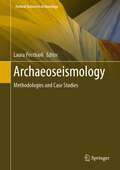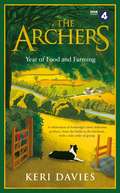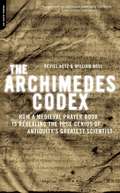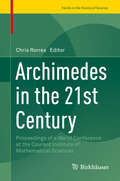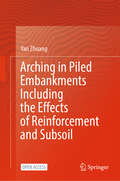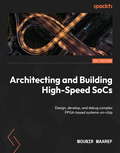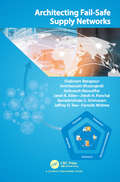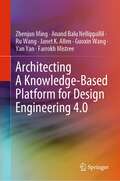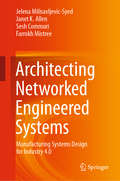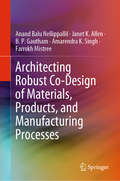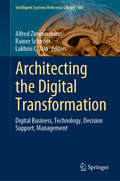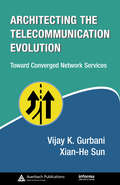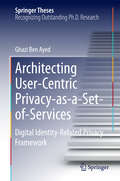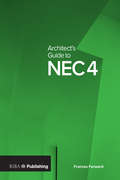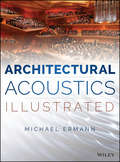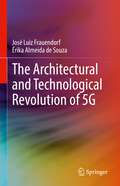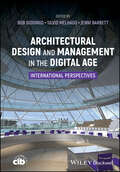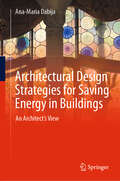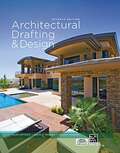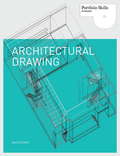- Table View
- List View
Archaeoseismology: Methodologies and Case Studies (Natural Science in Archaeology)
by Laura PecchioliArchaeoseismic research provides data and information on past earthquakes but is limited by the lack of ongoing discussions about methodology. This volume is an interdisciplinary approach including archaeologists, geologists, geophysicists, seismologists, engineers, and architects from different countries to present a comprehensive recording and interpretation of ancient natural disasters on some case studies. The publication is an introduction to various aspects of the field of archaeoseismology for the knowledge of past seismicity, the reconstruction of the chronological history of a place, the interpretation and identification of seismic effects using different methods, etc. The collection provides an overview of research into archaeoseismology, making new contributions through innovative ideas on various topics. The publication can be an illustrative introduction to better understand the complexity of interpreting seismic effects on ancient and modern masonries, particularly for students with an open mind.
The Archers Year Of Food and Farming: A celebration of Ambridge's most delicious produce, from the fields to the kitchens, with a side order of gossip
by Keri Davies'What's for tea, Clarrielove?' From the fabled kitchens of Ambridge come the recipes and gossip that fuel the nation's favourite village.Whether it's Susan's spicy chilli con carne on the hob or Helen's dramatic tuna bake in the oven, Jill's flapjacks stacked high or Alastair's Goan fish curry hotting up suppertime, this celebration of Ambridge life will take fans even closer to the heart of every Archers home.But this book isn't just a cook-along with our favourite families. It's full to the brim with tales and memories. The Archers Year of Food and Farming shares the ups and downs of the inhabitants of Ambridge and celebrates our countryside in all of its green and pleasant glory.Month-by-month, we learn more about the farming community and those big events in the Ambridge calendar: Shrove Tuesday and Easter, lambing, Open Farm Sunday, the village fete, Apple Day, the harvest, Stir-up Sunday and Deck the Hall.Rural traditions are alive and well in The Archers, but it's a contemporary world that is full of warmth, wit and the unexpected.
The Archers Year Of Food and Farming: A celebration of Ambridges most delicious produce, from the fields to the kitchens, with a side order of gossip
by Keri Davies'What's for tea, Clarrielove?' From the fabled kitchens of Ambridge come the recipes and gossip that fuel the nation's favourite village.Whether it's Susan's spicy chilli con carne on the hob or Helen's dramatic tuna bake in the oven, Jill's flapjacks stacked high or Alastair's Goan fish curry hotting up suppertime, this celebration of Ambridge life will take fans even closer to the heart of every Archers home.But this book isn't just a cook-along with our favourite families. It's full to the brim with tales and memories. The Archers Year of Food and Farming shares the ups and downs of the inhabitants of Ambridge and celebrates our countryside in all of its green and pleasant glory.Month-by-month, we learn more about the farming community and those big events in the Ambridge calendar: Shrove Tuesday and Easter, lambing, Open Farm Sunday, the village fete, Apple Day, the harvest, Stir-up Sunday and Deck the Hall.Rural traditions are alive and well in The Archers, but it's a contemporary world that is full of warmth, wit and the unexpected.
The Archimedes Codex: How a Medieval Prayer Book Is Revealing the True Genius of Antiquity's Greatest Scientist
by Reviel NetzPart archaeological detective story, part science, and part history, The Archimedes Codex tells the astonishing story of a lost manuscript, from its tenth-century creation in ancient Constantinople to the auction block at Christie’s in New York, and how a team of scholars used the latest imaging technology to reveal and decipher the original text. What they found was the earliest surviving manuscript by Archimedes (287 BC#150;212 BC), the greatest mathematician of antiquity#151;a manuscript that established, for the first time, the extent of his mathematical genius, which was two thousand years ahead of modern science.
Archimedes in the 21st Century: Proceedings of a World Conference at the Courant Institute of Mathematical Sciences (Trends in the History of Science)
by Chris RorresThis book is a collection of papers presented at the "Archimedes in the 21st Century" world conference, held at the Courant Institute of Mathematical Sciences in 2013. This conference focused on the enduring and continuing influence of Archimedes in our modern world, celebrating his centuries of influence on mathematics, science, and engineering. Archimedes planted the seeds for a myriad of seminal ideas that would grow over the ages. Each chapter surveys the growth of one or more of these seeds, and the fruit that they continue to bear to this day. The conference speakers contributing to this book are actively involved in STEM fields whose origins trace back to Archimedes, many of whom have conducted and published research that extends Archimedes' work into the 21st century. The speakers are not historians, so while historical context is provided, this book is uniquely focused on the works themselves as opposed to their history. The breadth and depth of Archimedes' influence will inspire, delight, and even surprise readers from a variety of fields and interests including historians, mathematicians, scientists, and engineers. Only a modest background in math is required to read this book, making it accessible to curious readers of all ages.
Arching in Piled Embankments Including the Effects of Reinforcement and Subsoil
by Yan ZhuangThis Open access book examined the performance of the reinforced piled embankments in both plane strain and three-dimensional conditions. The arching mechanisms involved in the piled embankments have been investigated by conducting a series of finite element analyses. A better understanding of the variation for the performance of the piled embankments along with the change of the embankment geometry and piles arrangement has been achieved. This book also considered predictions of reinforcement tension in a piled embankment from British standard BS 8006 published in 2010 and the 2012 amended version, and compared the results with finite-element model predictions. Good predictions of maximum reinforcement sag are achieved by slight modification of the BS 8006 method. Furthermore, the book considered the potentially beneficial contribution of a lightly overconsolidated clay subsoil layer, both in the finite-element predictions and as a simple modification to the BS 8006 predictive method. When compared to the finite-element results the proposed modified BS 8006 prediction is quite accurate. Finally, the concept of an interaction diagram and corresponding equation for use in design is proposed, which considered the effect of soil arching, the contribution of reinforcement and the subsoil. The calculation of the vertical stress carried by the subsoil due to arching effect and reinforcement for multilayered soil was proposed. The results show that subsoil gives a major contribution to overall vertical equilibrium, while the reinforcement gives obvious contribution at relatively large settlement. Good design practice is necessary to prevent excessive settlement of piled embankments. This book can enhance the understanding of the load transfer mechanism in piled embankments. The research results will provide a scientific basis and technical support for the settlement control of embankments for the design life of the infrastructure in soft soil areas.
Architecting and Building High-Speed SoCs: Design, develop, and debug complex FPGA-based systems-on-chip
by Mounir MaarefDesign a high-speed SoC while gaining a holistic view of the FPGA design flow and overcoming its challenges.Purchase of the print or kindle book includes a free eBook in the PDF format.Key FeaturesUse development tools to implement and verify an SoC, including ARM CPUs and the FPGA logicOvercome the challenge of time to market by using FPGA SoCs and avoid the prohibitive ASIC NRE costUnderstand the integration of custom logic accelerators and the SoC software and build themBook DescriptionModern and complex SoCs can adapt to many demanding system requirements by combining the processing power of ARM processors and the feature-rich Xilinx FPGAs. You'll need to understand many protocols, use a variety of internal and external interfaces, pinpoint the bottlenecks, and define the architecture of an SoC in an FPGA to produce a superior solution in a timely and cost-efficient manner. This book adopts a practical approach to helping you master both the hardware and software design flows, understand key interconnects and interfaces, analyze the system performance and enhance it using the acceleration techniques, and finally build an RTOS-based software application for an advanced SoC design. You'll start with an introduction to the FPGA SoCs technology fundamentals and their associated development design tools. Gradually, the book will guide you through building the SoC hardware and software, starting from the architecture definition to testing on a demo board or a virtual platform. The level of complexity evolves as the book progresses and covers advanced applications such as communications, security, and coherent hardware acceleration. By the end of this book, you'll have learned the concepts underlying FPGA SoCs' advanced features and you'll have constructed a high-speed SoC targeting a high-end FPGA from the ground up.What you will learnUnderstand SoC FPGAs' main features, advanced buses and interface protocolsDevelop and verify an SoC hardware platform targeting an FPGA-based SoCExplore and use the main tools for building the SoC hardware and softwareBuild advanced SoCs using hardware acceleration with custom IPsImplement an OS-based software application targeting an FPGA-based SoCUnderstand the hardware and software integration techniques for SoC FPGAsUse tools to co-debug the SoC software and hardwareGain insights into communication and DSP principles in FPGA-based SoCsWho this book is forThis book is for FPGA and ASIC hardware and firmware developers, IoT engineers, SoC architects, and anyone interested in understanding the process of developing a complex SoC, including all aspects of the hardware design and the associated firmware design. Prior knowledge of digital electronics, and some experience of coding in VHDL or Verilog and C or a similar language suitable for embedded systems will be required for using this book. A general understanding of FPGA and CPU architecture will also be helpful but not mandatory.
Architecting Fail‐Safe Supply Networks
by Shabnam Rezapour Amirhossein Khosrojerdi Golnoosh Rasoulifar Janet K. Allen Jitesh H. Panchal Ramakrishnan S. Srinivasan Jeffrey D. Tew Farrokh MistreeA fail-safe supply network is designed to mitigate the impact of variations and disruptions on people and corporations. This is achieved by (1) developing a network structure to mitigate the impact of disruptions that distort the network structure and (2) planning flow through the network to neutralize the effects of variations. In this monograph, we propose a framework, develop mathematical models and provide examples of fail-safe supply network design. We show that, contrary to current thinking as embodied in the supply network literature, disruption management decisions made at the strategic network design level are not independent from variation management decisions made at the operational level. Accordingly, we suggest that it is beneficial to manage disruptions and variations concurrently in supply networks. This is achieved by architecting fail-safe supply networks, which are characterized by the following elements: reliability, robustness, flexibility, structural controllability, and resilience. Organizations can use the framework presented in this monograph to manage variations and disruptions. Managers can select the best operational management strategies for their supply networks considering variations in supply and demand, and identify the best network restoration strategies including facility fortification, backup inventory, flexible production capacity, flexible inventory, and transportation route reconfiguration. The framework is generalizable to other complex engineered networks.
Architecting A Knowledge-Based Platform for Design Engineering 4.0
by Janet K. Allen Farrokh Mistree Anand Balu Nellippallil Yan Yan Zhenjun Ming Ru Wang Guoxin Wang"Design Engineering for Industry 4.0 (DE4.0) represents the 'human-cyber-physical view of the systems realization ecosystem “that is necessary to accommodate the drivers of Industry 4.0 (IoX) and provide an open ecosystem for the realization of complex systems. Seamless integration of digital threads and digital twins throughout the product design, the development and fulfillment lifecycle; the ability to accommodate diverse and rapidly changing technologies; and the mechanisms to facilitate the creation of new opportunities for the design of products, processes, services, and systems are some of the desired characteristics of DE4.0."Jiao, R., Commuri, S. Panchal, J., Milisavljevic-Syed, J, Allen, J.K., Mistree, F. and Schaefer, D., "Design Engineering in the Age of Industry 4.0," ASME Journal of Mechanical Design, 143(7), 070801, 25 pages.In keeping with the Design Engineering 4.0 construct the authors describe architecting a computer platform to support human designers make decisions associated with the realization of complex engineered systems. The platform is designed to facilitate end-to-end digital integration, customization and personalization, agile collaboration networks, open innovation, co-creation and crowdsourcing, product servitization and anything-as-a-service.Recognizing that simulation models are abstractions of reality the authors opt for a satisficing strategy instead of an optimization strategy. They include fundamentals and then describe tools for architecting a knowledge-based platforms for decision support. Challenges associated with developing a computational platform for decision support for the realization of complex engineered systems in the context of Design Engineering 4.0 are identified. Constructs for formulating design decisions (e.g., selection, compromise, and coupled decisions), knowledge modelling schemes (e.g., ontologies and modular templates), diagrams for designing decision workflows (e.g., the PEI-X diagram), and some analytical methods for robust design under uncertainty are presented. The authors describe integrating the knowledge-based platform to architect a cloud-based platform for decision support promoting co-design and cloud-based design communication essential for mass collaboration and open innovation for Design Engineering 4.0.This book is a valuable resource for researchers, design engineers, and others working on pushing the boundary of digitized manufacturing to include Design Engineering 4.0 principles in designing products, processes, and services.
Architecting Networked Engineered Systems: Manufacturing Systems Design for Industry 4.0
by Janet K. Allen Farrokh Mistree Jelena Milisavljevic-Syed Sesh CommuriIn this monograph, the authors demonstrate how the integration of adaptability, operability, and re-configurability in the design of complex systems is indispensable for the further digitization of engineering systems in smart manufacturing. Globalization of the customer base has resulted in distributed and networked manufacturing systems. However, current design methods are not suitable to address variations in product design, changes in production scale, or variations in product quality necessitated by dynamic changes in the market. Adaptability, operability, and re-configurability are key characteristics that are necessary to address the limitations of the current methods used to design networked manufacturing systems. In recent years, the digital transformation driving Industry 4.0 has had an enormous impact on globally distributed manufacturing. Digitalisation, the integration of digital technology into networked engineered systems, is increasingly being adopted to respond to changes in the market. This is achieved by means of (a) the concurrent design of adaptable systems, (b) addressing flexibility in design parameters, (c) conducting an operability analysis, and (d) employing a reconfiguration strategy to address faults and variances in product quality and re-establish connectivity among the elements in the system. The design of manufacturing systems in the age of Industry 4.0 is addressed in this monograph. The authors introduce the concept of a ‘smart platform’ and a computational framework for the digitalization of networked manufacturing systems. They also suggest how the framework and techniques in this monograph are applicable beyond the manufacturing domain for architecting networked engineered systems in other industries such as chemical processes and health care, that are being transformed through the adoption of the Industry 4.0 construct.
Architecting Robust Co-Design of Materials, Products, and Manufacturing Processes
by Anand Balu Nellippallil Janet K. Allen B. P. Gautham Amarendra K. Singh Farrokh MistreeThis book explores systems-based, co-design, introducing a “Decision-Based, Co-Design” (DBCD) approach for the co-design of materials, products, and processes.In recent years there have been significant advances in modeling and simulation of material behavior, from the smallest atomic scale to the macro scale. However, the uncertainties associated with these approaches and models across different scales need to be addressed to enable decision-making resulting in designs that are robust, that is, relatively insensitive to uncertainties. An approach that facilitates co-design is needed across material, product design and manufacturing processes. This book describes a cloud-based platform to support decisions in the design of engineered systems (CB-PDSIDES), which feature an architecture that promotes co-design through the servitization of decision-making, knowledge capture and use templates that allow previous solutions to be reused. Placing the platform in the cloud aids mass collaboration and open innovation.A valuable reference resource reference on all areas related to the design of materials, products and processes, the book appeals to material scientists, design engineers and all those involved in the emerging interdisciplinary field of integrated computational materials engineering (ICME).
Architecting the Digital Transformation: Digital Business, Technology, Decision Support, Management (Intelligent Systems Reference Library #188)
by Alfred Zimmermann Rainer Schmidt Lakhmi C. JainThis research-oriented book presents key contributions on architecting the digital transformation. It includes the following main sections covering 20 chapters: · Digital Transformation · Digital Business · Digital Architecture · Decision Support · Digital Applications Focusing on digital architectures for smart digital products and services, it is a valuable resource for researchers, doctoral students, postgraduates, graduates, undergraduates, academics and practitioners interested in digital transformation.
Architecting the Telecommunication Evolution: Toward Converged Network Services (Informa Telecoms & Media)
by Vijay K. Gurbani Xian-He SunService-oriented architecture (SOA) uses services as the baseline for developing new architectures and applications, as networks are built specifically to satisfy service requirements. Most services are currently handled over different networks, but newer services will soon require cross-network support. Architecting the Telecommunication Evolution
Architecting User-Centric Privacy-as-a-Set-of-Services: Digital Identity-Related Privacy Framework (Springer Theses)
by Ghazi Ben AyedHow could privacy play a key role in protecting digital identities? How could we merge privacy law, policies, regulations and technologies to protect our digital identities in the context of connected devices and distributed systems? In this book, the author addresses major issues of identity protection and proposes a service-oriented layered framework to achieve interoperability of privacy and secure distributed systems. The framework is intended to distill privacy-related digital identity requirements (business interoperability) into a set of services, which in turn can be implemented on the basis of open standards (technical interoperability). The adoption of the proposed framework in security projects and initiatives would decrease complexities and foster understanding and collaborations between business and technical stakeholders. This work is a step toward implementing the author's vision of delivering cyber security as a set of autonomous multi-platform hosted services that should be available upon user request and on a pay-per-use basis.
Architect’s Guide to NEC4
by Frances ForwardThis user friendly guide introduces, explains, and demystifies the NEC4 contract on a practical, work-based level. Made for architects by an architect, it explores the best approach to collaborative and contractual partnering work practices. Alongside explanations of the contracts and clauses, it presents the key areas of distinction from alternative standard form contracts and examines the integrated project management principles that bring the NEC4 contracts together as a whole. It's the perfect companion book for professionals who are new to the NEC contract family and former users trying to understand the latest updates.
Architectural Acoustics Illustrated
by Michael A. ErmannUnite the science of sound and the principles of design to enhance any spaceArchitectural Acoustics Illustrated translates the quantitative and qualitative content of acoustics into the graphic language of architecture. This highly-visual guide includes over 350 illustrations that outline the physics of sound and the best design practices for limiting or mitigating noise in buildings by using the latest in materials and techniques. Each chapter includes a summary checklist of design guidelines to help prevent mistakes and oversights, and the Instructor's website offers video animations demonstrating acoustical concepts. Designed as a "first look" at the interaction of sound and space, the book explains the principles of architectural acoustics and their practical applications, providing a comprehensive guide for designing with acoustics in mind.Architectural acoustics is more than just concert halls - it may determine building placement, division of interior space, exterior construction, and even siting. When addressed early in the design process, the resulting space can be free of unwanted sound and promote good hearing; if left unaddressed, the problems with the space can lead to lawsuits and costly post-construction remediation. Architectural Acoustics Illustrated helps designers solve most acoustical problems in advance, by enabling readers to:Understand the physical science underlying the behavior of soundConsider the interactions of sound and space in the initial design approachMitigate building sounds such as those produced by HVAC and plumbing with early design planningDesign spaces for listening, and incorporate acoustics best practices into every planThe highly visual format of the book helps readers grasp complex concepts quickly, and thorough discussion of each concept's real-world application ties the science directly into the design process. All design professionals need to have a fundamental understanding of acoustics, and Architectural Acoustics Illustrated is a comprehensive, practical guide in an easy-to-read format.
The Architectural and Technological Revolution of 5G
by José Luiz Frauendorf Érika Almeida de SouzaThe book discusses the evolution of cellular technology, then focusing in on 5G and its architecture and what it means for current engineers. The book first focuses on 4G and how it changed the industry, allowing people to communicate by connecting devices to the internet. The authors detail the emergence of services and applications that have revolutionized communication and continue to impact the daily habits of majority of the world's population. The authors endeavor to tell this story by showing the path taken until the arrival of 5G, detailing how technological and architectural progress evolved in all these years. It is a technical book, but the authors take care to explain in detail each aspect related to technology in order to allow everyone interested in the subject to delve into this important topic.Presents a comprehensive explanation about 4G and 5G architecture, modulation and protocols;Includes a thorough explanation of modern antennas technology and O-RAN;Relevant to technology professionals and students interested in 5G, but with little background in telecommunications;The English translation of this book from its Portuguese original manuscript was done with the help of artificial intelligence (machine translation by the service provider DeepL.com). A subsequent human revision of the content was done by the author.
Architectural Conservation and Restoration in Norway and Russia (Routledge Research in Architectural Conservation and Historic Preservation)
by Evgeny Khodakovsky Siri Skjold LexauNorway and Russia have been closely related through the ages, both geographically and historically, and have experienced similar problems relating to climate, building maintenance and national wooden architecture. As a result, the parallel study of architectural conservation and restoration theories and practices in both neighbouring Northern states makes for a stimulating collective monograph. Architectural Conservation and Restoration in Norway and Russia delves into the main challenges of historic and contemporary architectural preservation practices in the two countries. The book consists of three main parts: the discovery and preservation of historical architecture in the late nineteenth to early twentieth century; contemporary approaches to former restorations and the conservation and maintenance of historical architecture; and, finally, current questions concerning preservation of twentieth-century architectural heritage which, due to different building technologies and artistic qualities, demand revised methods and historical evaluation. This is a valuable resource for academics, researchers and students in different areas of architecture (medieval, nineteenth-century, wooden and contemporary architecture) as well as in the fields of art, architectural history, cultural heritage and Scandinavian and Russian studies.
Architectural Design and Management in the Digital Age: International Perspectives
by Bob Giddings Silvio Melhado Jenni BarrettCritical appraisal of architectural design and management in the digital age through international perspectives Architectural Design and Management in the Digital Age delivers an evaluation of digitalisation in the evolving processes of architecture, providing a holistic treatment of the subject in terms of technologies, human context, emerging concepts, and the management of digital projects. This book includes analysis of: the advantages of digital technology in appropriate circumstances but also to appreciate that alternative methods may continue to provide considerable benefits for other situations. the implications of the digital world for creativity and architectural quality, the diversity of people who could be involved, and reaching the disadvantaged and disenfranchised. the role of the architect and other professionals within design and management processes. how emphasis on data management is creating diverging practices, which involve new concepts and definitions that require interpretation, especially with regard to experiences of design processes in different countries. Providing fresh reflections on a myriad of timely topics, Architectural Design and Management in the Digital Age: International Perspectives is an essential resource for researchers, academics, and advanced students in architecture, design management, and construction, along with professionals in those disciplines.
Architectural Design Strategies for Saving Energy in Buildings: An Architect's View
by Ana-Maria DabijaArchitectural Design Strategies for Saving Energy in Buildings: An Architect's View employs an architect’s perspective, defined equally as art and engineering science, to the contemporary concept of designing buildings that use less energy. This approach to lowering energy consumption via integrated measures (both passive and active) offers a nuanced perspective on managing building efficiency — that energy saving is not a target in itself but results as a consequence of the architectural concept. The book does not provide calculations or levels of performance. Rather, by sticking to qualitative principles of architectural design and analyzing and using the force and laws of nature in shaping the built space, the author argues for decreasing energy consumption through the process of design, the principles of building physics, the volume of the building itself, and spatial configuration as it relates to the costs of operating the building. This approach contrasts the traditional construction system of only providing a thermal insulated ”blanket” over the envelope and equipment that produces energy from unconventional sources, which can be calculated according to regulations. Amidst the current discourse on sustainability and energy efficiency, this book offers a thought-provoking read for professionals in architecture, civil engineering, and construction, as well as graduate students in related courses. It presents an architect's approach to nearly zero-emission building design, analyses architectural strategies that efficiently use energy in buildings, and examines famous buildings and their innovative design as examples of good practice.
Architectural Drafting and Design
by David A. Madsen Alan Jefferis David P. MadsenARCHITECTURAL DRAFTING AND DESIGN, Seventh Edition, is the definitive text for beginning, intermediate, or advanced architectural CAD operators. This full-color, comprehensive edition covers the basics of residential design while exploring numerous types of projects that a designer or architect is likely to complete during the design process. <p><p>The Seventh Edition is up-to-date with content based on the most recent editions of relevant codes, including the 2015 International Residential Code (IRC), the 2015 International Building Code (IBC), the 2015 International Energy Conservation Code (IECC), and the 2012 International Green Construction Code (IgCC). The text opens with information on architectural styles that have dominated the field over the last four centuries, followed by basic design components related to site and structure. Commercial drafting, basic construction materials, common construction methods, and drawings typically associated with commercial construction are also covered. This bestseller complements informational content with practical, hands-on material, including step-by-step instructions for the design and layout of each type of drawing associated with a complete set of architectural plans—all presented via projects that can be completed using CAD drawing methods. This proven text equips readers with the knowledge and skills needed to complete the drawings that most municipalities require to obtain a building permit for a single-family residence.
Architectural Drawing
by David DernieThis book focuses on the exciting possibilities for representing the built environment with all the techniques – both ancient and modern – that are now available. It teaches students the following skills: how to draw using a range of media, the basic rules of making effective spatial images, how to read a drawing, and how to express ideas through appropriate media and forms of communication. Following a brief introduction, the book is divided into three sections: Media, Types and Places. Each section is illustrated with exemplary drawings and accompanying commentaries. Step-by-step sequences and practical tips will further help students to make the most of their newly acquired skills. This book is an indispensable practical and inspirational resource in architectural schools and practices alike.
Architectural Drawing (Portfolio Skills)
by David DernieThis book focuses on the exciting possibilities for representing the built environment with all the techniques – both ancient and modern – that are now available. It teaches students the following skills: how to draw using a range of media, the basic rules of making effective spatial images, how to read a drawing, and how to express ideas through appropriate media and forms of communication. Following a brief introduction, the book is divided into three sections: Media, Types and Places. Each section is illustrated with exemplary drawings and accompanying commentaries. Step-by-step sequences and practical tips will further help students to make the most of their newly acquired skills. This book is an indispensable practical and inspirational resource in architectural schools and practices alike.
Architectural Drawing, 2nd edition
by David DernieThis book focuses on the exciting possibilities for representing the built environment with techniques ranging from pencil sketching to computers. It teaches students the following skills: how to draw using a range of media, the basic rules of making effective spatial images, and how to express ideas through appropriate media and forms of communication. Following a revised and expanded introduction, the book is divided into three sections: Media, Types and Places. Each section is illustrated with exemplary drawings and accompanying commentaries. Step-by-step sequences and practical tips will further help students to make the most of their newly acquired skills. The second edition includes more on a variety of techniques, particularly digital, and new artworks from practising architects, making it an indispensable practical and inspirational resource.
Architectural Drawing Second Edition
by David DernieThis book focuses on the exciting possibilities for representing the built environment with techniques ranging from pencil sketching to computers. It teaches students the following skills: how to draw using a range of media, the basic rules of making effective spatial images, and how to express ideas through appropriate media and forms of communication. Following a revised and expanded introduction, the book is divided into three sections: Media, Types and Places. Each section is illustrated with exemplary drawings and accompanying commentaries. Step-by-step sequences and practical tips will further help students to make the most of their newly acquired skills. The second edition includes more on a variety of techniques, particularly digital, and new artworks from practising architects, making it an indispensable practical and inspirational resource.
